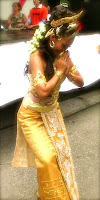
“America’s Gypsy”
Ana Berry travels the world within America, taking us on cultural adventures in our own cities. See them as mini vacations that not only entertain us but also immerse us in the local cultures living in this large country.
Today we are headed to Korea town! Located in the Mid-Wilshire district of Los Angeles, Korea town is rich with historic brownstones, high-end Asian boutiques, food markets and spas. Many Korean immigrants and investors came to California during the 1960s, after restrictions on immigration to the United States from East Asia were lifted. Now, Korea town is considered one of the most diverse neighborhoods in America with a Korean population of 160-thousand people within 5 square miles, making it the largest concentration of Koreans outside of Korea.
It was another day of hustle and bustle in Los Angeles and I needed to relax! I heard of these so-called Korean Day Spas, but in this city, luxury comes at a high price. Not in Korea town! For under a hundred dollars, I spent hours in an all woman’s’ Korean spa or, Jimjilbang. My Ajuma (the term for the woman giving you your treatment) salted and scrubbed me like a piece of meat, being seasoned for the BBQ and even though she was barely 5 feet tall and practically naked, she was extremely strong and thorough. I was in a mermaid’s oasis, circulating my senses by soaking in hot baths, plunging in cold tubs, napping in dry saunas and sweating in steam rooms. After a few hours in the spa, I was clean, relaxed and invigorated for the Korean adventures that awaited the day.
The streets of Korea town took me out of Los Angeles and into a snippet of Seoul. The tall buildings were filled with Korean billboards above me, as hundreds of people walked in and out of local Korean boutiques and restaurants beside me.
So I decided to join them! I entered the 24-hour ‘Tofu House’ and was greeted by an array of “Anyon Haseo’s”. Upon being seated, I was immediately served "banchan”, traditional side dishes that come with the meal. They included odaeng (fish cakes), mu (radish), shigumchi (spinach leaves), and spicy pickled kimchee (which contains vitamin c, fiber and stimulates the appetite). I ordered the mehoontang, (hot fish soup) which was like a witch’s cauldron, spices bubbling from the top of the iron bowl. The Korean waitress spoke no English but explained to me with her hands how to crack an egg and stir it in the boiling soup. Delicious, spicy, tangy and slightly sweet.
The meal was so delicious I had to buy some of these Korean delicacies as a souvenir snack. At the ‘Hank Kook Market’, I found exactly what I wanted; saltwater eel (jang uh), pickled Kimchee, and Korean rice wine (dongdong ju). Korean food is quite exotic and different from other Asian cuisines. And most Korean dishes are healthy because they use very little oil, fat and grease.
Full from my mehoontang and relaxed from my jimjilbang, I needed a drink. And to complete my gypsy caravan in Korea town, I wanted one last Korean cultural adventure; to sip Soju and to sing Karaoke. It was ‘Elvis Night’ at The Brass Monkey, a Karaoke hot spot, and Blue Moon was being serenaded to a group of giggling girls in the Korean language. Sipping my last drop of Soju, I got up and sang, Love Me Tender, to a bunch of smiling strangers. In this moment of being in a Korean Karaoke bar singing American music, I felt the magic of connecting with cultures.
As the sun began to set, the bright neon lights took over the skyline of Korea town. And even though I have never been to Korea, I felt like I had just explored the soul of Seoul in America!
Other cities that have Korea Town are Manhattan, Orange County, Seattle, Atlanta, Doraville, Chicago, Boston, Baltimore, Dallas, and Kansas City.
Korean Language
Hello: Annyeonghi Haseo (un young ha say o)
Thank you: Kamsamnida (kam sam nee da)
Goodbye: Annyeonghi gaseyo (un young ga say o)












